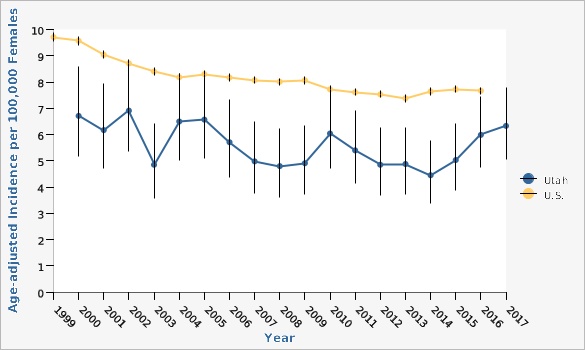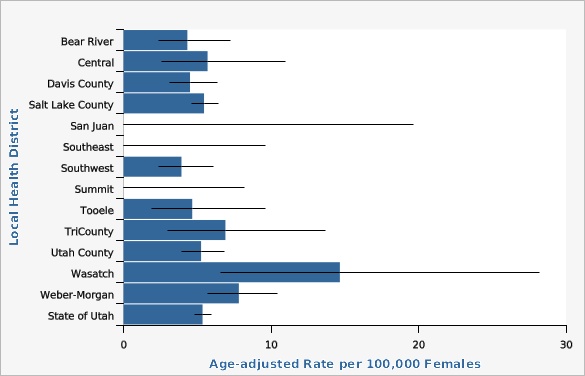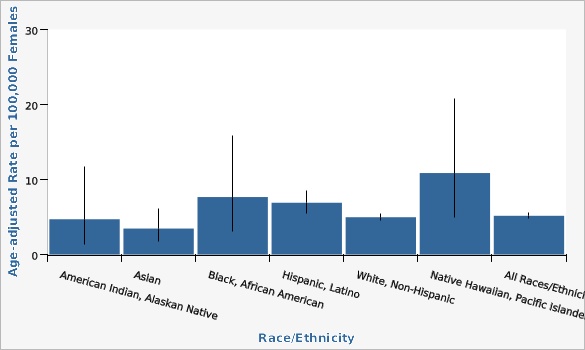Complete Health Indicator Report of Cervical Cancer Incidence
Definition
The rate of cervical cancer incidence in Utah or U.S. per 100,000 females.Numerator
The number of cervical cancer incidents among Utah or U.S. women (ICD-9: 180.0-180.9 and ICD-10: C53).Denominator
The female population of Utah or U.SWhy Is This Important?
Almost all cases of cervical cancer are caused by infection with high-risk types of the human papillomavirus (HPV). The HPV vaccine protects against the HPV types that most often cause cervical cancer. Other risk factors include smoking, immunosuppression, chlamydia infection, diet, oral contraceptives, family history, young age at the first full-term pregnancy, and multiple full-term pregnancies. Cervical cancer usually can be found early by having regular Pap tests. Between 60% and 80% of American women who are diagnosed with invasive cervical cancer have not had a Pap test in the past five years. ^1^[[br]] Cervical cancer is one of the most curable cancers if detected early through routine screening. With the availability of screening tests and the HPV vaccine, cervical cancer is also highly preventable. "1. [https://www.medicinenet.com/pap_smear/article.htm#pap_smear_facts]"Healthy People Objective C-10:
Reduce invasive uterine cervical cancerU.S. Target: 7.2 new cases per 100,000 females
State Target: currently being revised
Other Objectives
Utah Cancer Action Network Targets for Change:[[br]] Reduce the rate of cervical cancer diagnosed at an advanced (regional or distant) stage among women ages 20 to 64.[[br]]How Are We Doing?
Utah's cervical cancer rate has not significantly changed over the past two decades. The most recent data (2017) indicates a cervical cancer incidence rate of 6.33 cases per 100,000 women in Utah. For combined years 2013-2017 among Utah Health Districts, cervical cancer incidence rates ranged from a high in Wasatch District of 14.7 cases per 100,000 women (significantly higher than the statewide rate of 5.36 during this time frame) to a low of 3.9 cases per 100,000 women in the Southwest Health District.How Do We Compare With the U.S.?
Utah's rate of women diagnosed with cervical cancer has been lower than the U.S. rate for the past decade. The rate of cervical cancer incidence in the U.S. in 2016 (most recent year data available nationally) was 7.7 cases per 100,000 women compared with the Utah rate of 6 cases per 100,000 women.What Is Being Done?
The Utah Cancer Control Program (UCCP) in the Utah Department of Health (UDOH) provides free cervical cancer screenings to uninsured or under-insured women ages 21-64 years whose income is at or below the 250% federal poverty level. Women in need of cancer treatment are enrolled into Medicaid as per the Breast and Cervical Cancer Treatment Act. Visit [http://www.cancerutah.org] [[br]]or call 1-800-717-1811 for more information or to see if you qualify for free cervical cancer screening services. The UCCP also works with health-systems to implement evidence-based practices to improve cancer screening rates. The Utah Comprehensive Cancer Control program (CCC) and its affiliated coalition, the Utah Cancer Action Network (UCAN), work together with state and local partners to reduce the burden of cancer in Utah. Their mission is to lower cancer incidence, morbidity, and mortality in Utah through collaborative efforts directed toward cancer prevention and control. As a result, they support community-based strategies around food security, healthy neighborhoods, access to health care, and financial toxicity in order to prevent cancer; detect cancer early; and improve the lives of cancer survivors, caregivers, and their families. Additionally, CCC receives funding to implement cancer prevention and control strategies identified by the program and UCAN coalition.Available Services
The Utah Cancer Control Program (UCCP) in the Utah Department of Health (UDOH) provides free cervical cancer screenings to uninsured or under-insured women ages 21-64 years whose income is at or below the 250% federal poverty level. Women in need of cancer treatment are enrolled into Medicaid as per the Breast and Cervical Cancer Treatment Act. Visit [http://www.cancerutah.org] [[br]]or call 1-800-717-1811 for more information or to see if you qualify for free cervical cancer screening services.Health Program Information
In 1976, the UDOH received a cervical cancer grant from the National Cancer Institute. In 1980, the UDOH began providing clinical breast exams and Pap tests on a sliding fee scale. In 1993, state funding was appropriated for mammography. That same year the UCCP first received a capacity building grant from the Centers for Disease Control and Prevention to conduct breast and cervical cancer screening in Utah. A comprehensive grant was awarded to the program in 1994 to continue breast and cervical cancer screening. Since 1994, the UCCP and partners, including local health departments, mammography facilities, pathology laboratories, and private providers, have worked together to ensure the appropriate and timely provision of clinical services. The UCCP continues to receive funding from the CDC for breast and cervical cancer screening. Additionally, the Utah Comprehensive Cancer Control program (CCC) receives funding to implement cancer prevention and control strategies identified by the program and the Utah Cancer Action Network (UCAN) coalition.Related Indicators
Relevant Population Characteristics
Economically disadvantaged persons are significantly less likely to get a Pap test. Women are also more likely to receive screening tests as their level of education increases.Related Relevant Population Characteristics Indicators:
Health Care System Factors
As part of the Affordable Care Act, women can receive free preventive services such as Pap smears.Related Health Care System Factors Indicators:
Risk Factors
Any woman who is sexually active is at risk for developing cervical cancer. Other risk factors include having sexual relations at an early age, having multiple sex partners or a partner with many other partners, having a weakened immune system, not getting the HPV vaccine, family history, young age at first full-term pregnancy, multiple full-term pregnancies, diet and cigarette smoking.Related Risk Factors Indicators:
Related Health Status Outcomes Indicators:
Graphical Data Views
| Utah vs. U.S. | Year | Age-adjusted Incidence per 100,000 Females | Lower Limit | Upper Limit | ||
|---|---|---|---|---|---|---|
Record Count: 36 | ||||||
| Utah | 2000 | 6.7 | 5.2 | 8.6 | ||
| Utah | 2001 | 6.2 | 4.7 | 8.0 | ||
| Utah | 2002 | 6.9 | 5.4 | 8.8 | ||
| Utah | 2003 | 4.8 | 3.6 | 6.4 | ||
| Utah | 2004 | 6.5 | 5.0 | 8.3 | ||
| Utah | 2005 | 6.6 | 5.1 | 8.4 | ||
| Utah | 2006 | 5.7 | 4.4 | 7.4 | ||
| Utah | 2007 | 5.0 | 3.7 | 6.5 | ||
| Utah | 2008 | 4.8 | 3.6 | 6.2 | ||
| Utah | 2009 | 4.9 | 3.7 | 6.4 | ||
| Utah | 2010 | 6.0 | 4.7 | 7.6 | ||
| Utah | 2011 | 5.4 | 4.1 | 6.9 | ||
| Utah | 2012 | 4.8 | 3.7 | 6.3 | ||
| Utah | 2013 | 4.9 | 3.7 | 6.3 | ||
| Utah | 2014 | 4.4 | 3.4 | 5.8 | ||
| Utah | 2015 | 5.0 | 3.9 | 6.4 | ||
| Utah | 2016 | 6.0 | 4.8 | 7.4 | ||
| Utah | 2017 | 6.3 | 5.1 | 7.8 | ||
| U.S. | 1999 | 9.7 | 9.6 | 9.9 | ||
| U.S. | 2000 | 9.6 | 9.4 | 9.7 | ||
| U.S. | 2001 | 9.0 | 8.9 | 9.2 | ||
| U.S. | 2002 | 8.7 | 8.6 | 8.9 | ||
| U.S. | 2003 | 8.4 | 8.3 | 8.6 | ||
| U.S. | 2004 | 8.2 | 8.0 | 8.3 | ||
| U.S. | 2005 | 8.3 | 8.2 | 8.4 | ||
| U.S. | 2006 | 8.2 | 8.0 | 8.3 | ||
| U.S. | 2007 | 8.1 | 7.9 | 8.2 | ||
| U.S. | 2008 | 8.0 | 7.9 | 8.2 | ||
| U.S. | 2009 | 8.1 | 7.9 | 8.2 | ||
| U.S. | 2010 | 7.7 | 7.6 | 7.9 | ||
| U.S. | 2011 | 7.6 | 7.5 | 7.8 | ||
| U.S. | 2012 | 7.5 | 7.4 | 7.7 | ||
| U.S. | 2013 | 7.4 | 7.2 | 7.5 | ||
| U.S. | 2014 | 7.6 | 7.5 | 7.8 | ||
| U.S. | 2015 | 7.7 | 7.6 | 7.9 | ||
| U.S. | 2016 | 7.7 | 7.5 | 7.8 | ||
Data Notes
Age-adjusted to U.S. 2000 population.[[br]] ^ ^ U.S. Data only available through 2016 [[br]]Data Sources
- Cancer data provided by the Utah Cancer Registry, supported by the National Cancer Institute (HHSN261201800016I), the U.S. Center for Disease Control and Prevention (NU58DP0063200), the University of Utah, and Huntsman Cancer Foundation
- U.S. Cancer Statistics: WONDER Online Database. United States Department of Health and Human Services, Centers for Disease Control and Prevention and National Cancer Institute. Accessed at [http://wonder.cdc.gov/cancer.html]
| Local Health District | Age-adjusted Rate per 100,000 Females | Lower Limit | Upper Limit | Note | ||
|---|---|---|---|---|---|---|
Record Count: 14 | ||||||
| Bear River | 4.3 | 2.4 | 7.3 | |||
| Central | 5.7 | 2.6 | 11.0 | |||
| Davis County | 4.5 | 3.1 | 6.3 | |||
| Salt Lake County | 5.5 | 4.6 | 6.4 | |||
| San Juan | ** | 0.6 | 19.6 | **,^ | ||
| Southeast | ** | 0.6 | 9.6 | **,^ | ||
| Southwest | 3.9 | 2.4 | 6.1 | |||
| Summit | ** | 0.5 | 8.2 | ** | ||
| Tooele | 4.7 | 1.9 | 9.6 | |||
| TriCounty | 6.9 | 3.0 | 13.7 | |||
| Utah County | 5.3 | 4.0 | 6.9 | |||
| Wasatch | 14.7 | 6.6 | 28.2 | |||
| Weber-Morgan | 7.8 | 5.7 | 10.5 | |||
| State of Utah | 5.4 | 4.8 | 6.0 | |||
Data Notes
Age-adjusted to U.S. 2000 population. [[br]] ^ ^**The estimate has been suppressed because the observed number of events is very small and not appropriate for publication. For more information, please go to [http://ibis.health.utah.gov/pdf/resource/DataSuppression.pdf] [[br]] ^Prior to 2015 San Juan County was part of the Southeast Local Health District. In 2015 the San Juan County Local Health District was formed. Data reported are for all years using the current boundaries.Data Source
Cancer data provided by the Utah Cancer Registry, supported by the National Cancer Institute (HHSN261201800016I), the U.S. Center for Disease Control and Prevention (NU58DP0063200), the University of Utah, and Huntsman Cancer Foundation| Race/Ethnicity | Age-adjusted Rate per 100,000 Females | Lower Limit | Upper Limit | |||
|---|---|---|---|---|---|---|
Record Count: 7 | ||||||
| American Indian, Alaskan Native | 4.7 | 1.4 | 11.7 | |||
| Asian | 3.5 | 1.8 | 6.1 | |||
| Black, African American | 7.7 | 3.0 | 15.9 | |||
| Hispanic, Latino | 6.9 | 5.5 | 8.5 | |||
| White, Non-Hispanic | 5.0 | 4.6 | 5.4 | |||
| Native Hawaiian, Pacific Islander | 10.9 | 4.9 | 20.8 | |||
| All Races/Ethnicities | 5.2 | 4.8 | 5.6 | |||
Data Notes
Age-adjusted to U.S. 2000 population.Data Source
Cancer data provided by the Utah Cancer Registry, supported by the National Cancer Institute (HHSN261201800016I), the U.S. Center for Disease Control and Prevention (NU58DP0063200), the University of Utah, and Huntsman Cancer FoundationReferences and Community Resources
Utah Cancer Control Program @ [http://www.cancerutah.org][[br]] Utah Cancer Action Network @ [http://www.ucan.cc][[br]] American Cancer Society @ [http://www.cancer.org][[br]] National Cancer Institute @ [http://www.cancer.gov][[br]] Huntsman Cancer Institute @ [http://www.huntsmancancer.org][[br]] Centers for Disease Control and Prevention @ [http://www.cdc.gov][[br]] American Society of Clinical Oncology @ [http://www.asco.org]More Resources and Links
Evidence-based community health improvement ideas and interventions may be found at the following sites:- Centers for Disease Control and Prevention (CDC) WONDER Database, a system for disseminating public health data and information.
- United States Census Bureau data dashboard.
- Utah healthy Places Index, evidence-based and peer-reviewed tool, supports efforts to prioritize equitable community investments, develop critical programs and policies across the state, and much more.
- County Health Rankings
- Kaiser Family Foundation's StateHealthFacts.org
- Medical literature can be queried at PubMed library.
Page Content Updated On 10/28/2021,
Published on 11/10/2022



